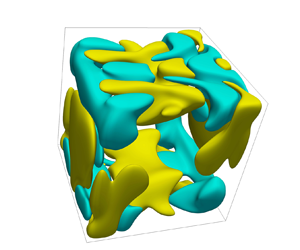Article contents
Global linear instability analysis of thermal convective flow using the linearized lattice Boltzmann method
Published online by Cambridge University Press: 30 June 2022
Abstract

Modal global linear stability analysis of thermal convection is performed with the linearized lattice Boltzmann method (LLBM). The onset of Rayleigh–Bénard convection in rectangular cavities with conducting and adiabatic sidewalls and the instability of two-dimensional (2-D) and three-dimensional (3-D) natural convection in cavities are studied. The method of linearizing the local equilibrium probability distribution function that was first proposed by Pérez et al. (Theor. Comp. Fluid Dyn., vol. 31, 2017, pp. 643–664) is extended to solve the coupled linear Navier–Stokes equations together with the linear energy equation in this work. A multiscale analysis is also performed to recover the macroscopic linear Navier–Stokes equations from the discrete lattice Boltzmann equations for both the single and multiple relaxation time models. The present LLBM is implemented in the framework of the Palabos library. It is validated by calculating the linear critical value of 2-D natural convection that the LLBM with the multiple relaxation time model has an error less than 1 % compared with the spectral method. The instability mechanism of the flow is explained by kinetic energy transfer analysis. It is shown that the buoyancy mechanism and inertial mechanism tend to stabilize the Hopf bifurcation of the 2-D natural convection at Pr < 0.08 and Pr > 1, respectively. For 3-D natural convection, subcritical bifurcation of the Hopf type is found for low-Prandtl-number fluids (Pr < 0.1).
JFM classification
Information
- Type
- JFM Papers
- Information
- Copyright
- © The Author(s), 2022. Published by Cambridge University Press
References
- 16
- Cited by


